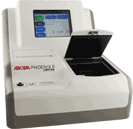- Home
- Tuotteet
- Prosessimittaukset
- Ametek
- XRF
- Ametek PHOENIX II DE
Ametek PHOENIX II DE
- General Details
- Specification
- Application Notes
- Certificate
PHOENIX II DE
Features and Benefits
- 30kV X-ray tube
- Direct excitation using X-ray tube
- Source filter for optimizing excitation conditions
- Rugged proportional counter detector
- Onboard computer with touch-screen interface
- Windows™ operating system
- Networking capability
- Simple one-button analysis
- Low cost of ownership
Benchtop ED-XRF Analyzer
The PHOENIX II DE is an Energy Dispersive-X-Ray Fluorescent (ED-XRF) benchtop analyzer that offers extreme simplicity of operation in a low cost compact design. It is ideal for elemental analysis of liquids, solids, pastes, slurries and powders for various elements qualitatively and quantitatively. This ED-XRF spectrometer has been designed for use in the rugged environment of production process and quality control, but is also well suited for the laboratory. An onboard PC makes use of Windows™ operating system along with a simple, intuitive touchscreen display, making analysis easy for nontechnical operators, but advanced enough for even the more experienced user as well.
The PHOENIX II DE combines direct source X-rays, optional source and/or detector filter, and a rugged gas-filled proportional counter detection system, giving the PHOENIX II DE improved performance. The detector design yields a high X-ray count rate throughput and utilizes a detector filter for specific applications to enhance analytical performance. With its onboard computer, no external computer is needed. The PHOENIX II DE does not require an external mouse or keyboard, yet offers USB, VGA and Ethernet connections for networking and connecting to external devices. This compact, simple to operate XRF system offers a unique combination of close-coupled geometry with a rugged detector for high sample throughput at a very affordable price and low cost of ownership.
ASOMA Instruments was established in Austin, Texas, in 1979 as one of the first companies to offer low-cost benchtop ED-XRF instrumentation. Throughout the next decade and a half, ASOMA became established as an industry leader with the development and release of the Models 100, 200 and 200T-series, PHOENIX and Titan line of XRF analyzers, as well as on-line instrumentation for measuring sulfur in liquid hydrocarbon streams.
Typical Applications include:
- Sulfur in diesel, gasoline, crude oil, bunker fuel, other petroleum distillates
- Titanium, Iron and Zinc in cosmetics
- Chlorine in rubber
- Sulfur and Metals in residual oil
- Bromine in foam
- Antimony and Bromine in plastics
- Chromium, Copper and Arsenic in various wood preservatives
- Pentachlorophenol in wood preservatives
- Titanium in various matrices
- Zinc and Titanium in plastics
- Iron in silica sand
- Iron in cocoa
Many other applications possible
Technical Data
Excitation
- Direct X-ray excitation
- Side-window X-ray tube
- Configured with one of a wide selection of anodes
- Max voltage 30 kV
- Max power 9 W
- Optional source filter
Detection Systems
- Rugged gas-filled proportional counter detector
- Gas fill optimized for application
- Automatic energy drift compensation
- Optional detector filter
Sample Chamber
- Single position (30mm cups)
- Bulk or flat samples (12 x 12 x 3 cm)
- Analysis of solids, liquids, powders, pastes, slurries, coatings, films, filter deposits
- Sample Spinner (optional)
Spectrometer Data
- Voltage: 120 or 230 VAC, 60W
- Dimensions: W x D x H: 38 x 46 x 31 cm (15 x 18 x 12”)
- Weight: 18 kg (40 lbs)
Other Features
- Software/User Interface
- Touch-screen display
- Embedded Panel PC computer
- Password protection
- Windows™ operating system
- USB and Ethernet connections
- Networking capability
- External monitor connection
- Onboard thermal printer
Product Data Sheet
Application Notes
- Analysis of Iron in Cocoa Products Using Direct Excitation
- Analysis of Sulfur in Carbon Black Using Direct Excitation
- Analysis of Sulfur in Crude Oil Using Direct Excitation
- Analysis of Sulfur in Diesel Fuel Using Direct Excitation
- Analysis of Sulfur in Petroleum Coke Using Direct Excitation
- Analysis of Sulfur, Vanadium, Iron & Nickel in Residual Oil Using Direct Excitation
- Analysis of Bromine, Antimony, & Zinc in Polystyrene Using Direct Excitation
- Analysis of Bromine in Styrofoam Using Direct Excitation
- Analysis of Copper, Chromium, Chlorine, Zinc, & Arsenic in Treated Wood Using Direct Excitation
- Analysis of Titanium in Nylon Sheets Using Direct Excitation
- Analysis of Zinc in Polystyrene Using Direct Excitation
- Analysis of Chlorine in Rubber and Windshield Wiper Blades Using Direct Excitation
- Analysis of Titanium Oxide, Iron Oxide & Zinc Oxide in Cosmetics Using Direct Excitation
- Analysis of Bismuth in Tablets and Liquids Using Direct Excitation

